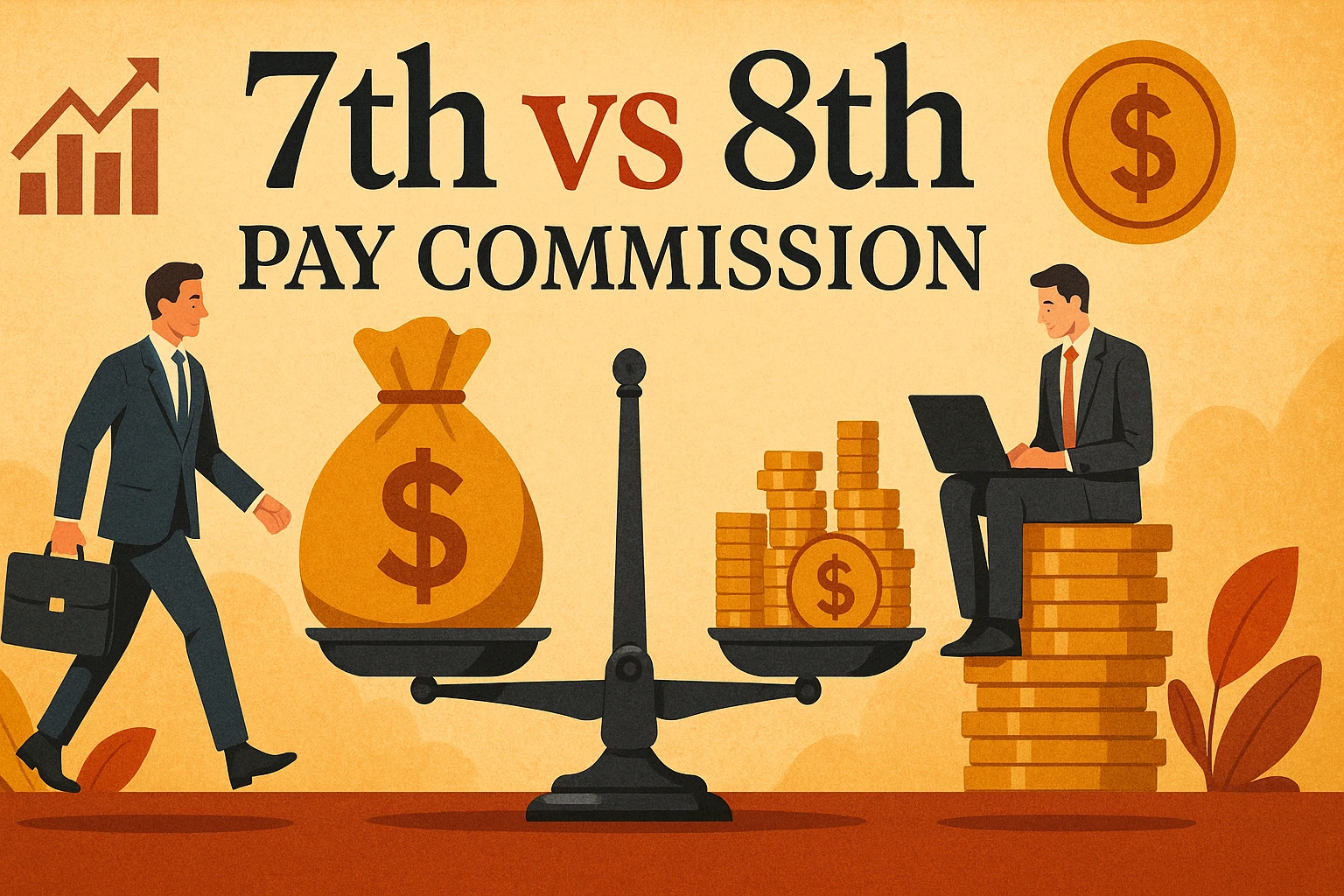The Pay Commission system in India plays a critical role in revising the salary structure, allowances, pensions, and benefits of central government employees. While the 7th Pay Commission brought significant changes, discussions about the 8th Pay Commission have already begun. This article explains the key differences between the 7th and expected 8th Pay Commissions, their features, recommendations, and likely implications.
What is a Pay Commission?
A Pay Commission is a central government-appointed body that recommends changes to the salary structure of government employees.
It is typically formed every ten years to revise basic pay, grade pay, allowances, and pension schemes based on inflation, cost of living, and changing economic conditions. The recommendations are applicable to central government employees, armed forces, and sometimes influence state pay structures too.
7th Pay Commission: Key Highlights
Implemented in 2016, the 7th Pay Commission overhauled the salary system by removing grade pay and introducing a simplified pay matrix. It aimed to increase transparency and uniformity in government pay scales. Below are its key features.
| Feature | 7th Pay Commission Details |
| Implementation Year | January 1, 2016 (effective from) |
| Minimum Basic Pay | ₹18,000 per month |
| Maximum Basic Pay | ₹2,50,000 per month (Cabinet Secretary level) |
| Fitment Factor | 2.57 |
| Pay Matrix | Introduced to replace Pay Band and Grade Pay |
| HRA | 24%, 16%, 8% depending on city class |
| DA Formula | 50% of basic pay triggers automatic merger |
| Arrears | Paid from January 1, 2016 |
8th Pay Commission: What to Expect?
The 8th Pay Commission is expected to be implemented around 2026, following the 10-year revision cycle. It is anticipated to address concerns like rising inflation, outdated DA structures, and the need for dynamic pay revision. Though not officially announced yet, various expectations are already being discussed.
| Feature | Expected Changes |
| Implementation Year | 2026 (tentative) |
| Likely Minimum Pay | ₹26,000 to ₹30,000 per month |
| Likely Maximum Pay | ₹3,00,000 to ₹3,25,000 per month |
| Revised Fitment Factor | Likely to increase from 2.57 to 3.0 or more |
| Dynamic Pay Revision | Annual or biennial revision proposal |
| Allowance Restructuring | Focus on inflation-based revision |
| Pension Upgrades | Possible boost to Old Pension Scheme (OPS) |
| Technology Integration | Automation in pay processing and tracking |
7th vs 8th Pay Commission: Key Differences
This section highlights the major differences between the 7th vs 8th Pay Commission. These differences reflect evolving economic realities and employee expectations in the public sector.
7th vs 8th Pay Commission: Key Differences | ||
| Criteria | 7th Pay Commission | 8th Pay Commission (Expected) |
| Implementation Year | 2016 | 2026 |
| Minimum Pay | ₹18,000 | ₹26,000 – ₹30,000 |
| Maximum Pay | ₹2.5 lakh | ₹3 lakh – ₹3.25 lakh |
| Fitment Factor | 2.57 | 3.0 or higher |
| Pay Matrix | Introduced | Likely revised/updated matrix |
| Dynamic Pay Adjustment | Not included | May include annual DA merger |
| Technology Integration | Basic | Advanced tracking systems |
| Pension System | Continued NPS | Possible review of OPS demands |
| Allowance Review | Based on fixed categories | More inflation-linked categories |
7th vs 8th Pay Commission Fitment Factor: Why It Matters
The fitment factor determines the multiplication used to calculate new salaries from old ones. In the 7th CPC, the fitment factor was set at 2.57. The 8th Pay Commission is expected to increase it to 3.0 or higher, significantly raising take-home pay. A higher factor ensures better alignment with inflation and purchasing power.
| Pay Level | Existing Basic (7th CPC) | With Fitment Factor 3.0 (Expected) |
| Level 1 | ₹18,000 | ₹54,000 |
| Level 5 | ₹29,200 | ₹87,600 |
| Level 10 | ₹56,100 | ₹1,68,300 |
House Rent Allowance (HRA) Revisions 7th vs 8th Pay Commission
Under the 7th Pay Commission, HRA was calculated as 24%, 16%, and 8% based on city classification. Employees now expect the 8th Pay Commission to revise these slabs due to increased rental costs. A move toward 30%, 20%, and 10% is being discussed in employee circles, though not confirmed officially.
| City Class | 7th CPC HRA | 8th CPC Proposed HRA |
| X (Metro) | 24% of Basic Pay | 30% of Basic Pay |
| Y (Tier 2 Cities) | 16% of Basic Pay | 20% of Basic Pay |
| Z (Tier 3 Cities) | 8% of Basic Pay | 10% of Basic Pay |
Pension Schemes: NPS vs OPS Demands
The 7th CPC retained the National Pension Scheme (NPS), but many unions are calling for the return of the Old Pension Scheme (OPS). The 8th CPC is likely to consider pension reform seriously, especially for pre-2004 and long-serving employees.
| Feature | NPS (7th CPC) | OPS (Demanded under 8th CPC) |
| Contribution | Employee + Govt. | Only Govt. Contributed |
| Retirement Benefit | Market-linked | Fixed monthly pension |
| Withdrawal Rules | Subject to conditions | Guaranteed with years of service |
| Security | Variable | Stable and predictable |
Dearness Allowance (DA): Static vs Dynamic Adjustment
The 7th CPC increased DA biannually but only merged it with the basic pay after reaching 50%. The 8th CPC may propose a more dynamic system where DA gets automatically merged once it crosses a threshold, or introduce annual increments based on inflation data to better counter rising living costs.
Way Forward
The 7th Pay Commission laid the foundation for rationalizing government salaries, but it also highlighted issues such as stagnation in real wages and disparities between Centre and States. As the 8th Pay Commission approaches, it is vital to address these concerns while ensuring fiscal discipline and administrative simplicity. A forward-looking approach must include reforms in structure, performance, and transparency.
7th vs 8th Pay Commission FAQs
Q1. What is the difference between the 7th vs 8th Pay Commission?
The 7th Pay Commission was implemented in 2016 and focused on rationalizing pay scales and removing grade pay. The 8th Pay Commission is expected to revise salaries further, address inflation impact, and possibly restructure allowances and pension formulas.
Q2. Has the 8th Pay Commission been announced?
As of now, the 8th Pay Commission has not been officially announced by the Government of India. However, central employees and unions are demanding its constitution, likely to be effective around 2026.
Q3. What was the implementation date of the 7th Pay Commission?
The recommendations of the 7th CPC were implemented from 1st January 2016, with revised salary and pension structures for central government employees and pensioners.
Q4. What is the expected salary hike in the 8th Pay Commission?
Although no official numbers are confirmed, experts suggest a minimum salary hike of 20–25%, subject to inflation, DA levels, and government affordability.
Q5. Will the 8th Pay Commission change the pension scheme?
There is growing demand for a return to the Old Pension Scheme (OPS). The 8th CPC may review pension structures, but any major change would require legislative or policy-level decision.







